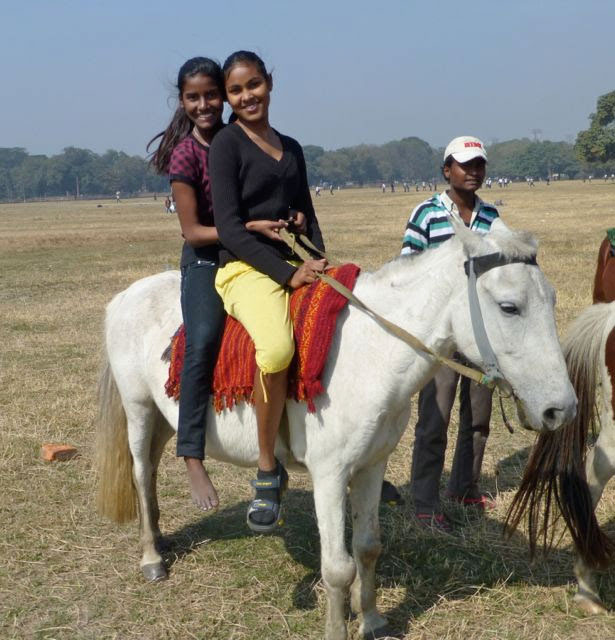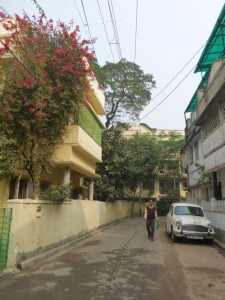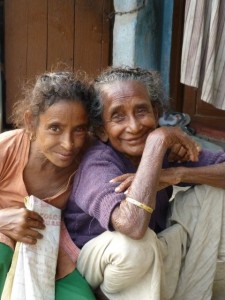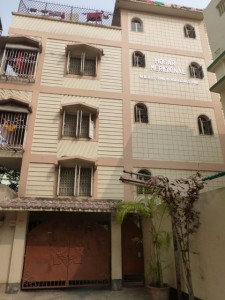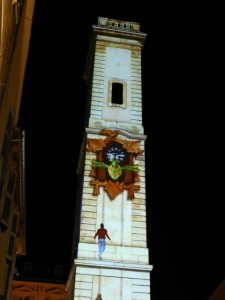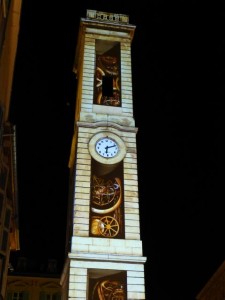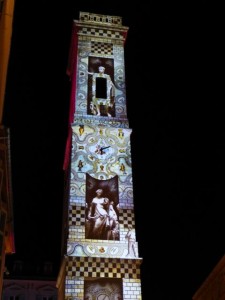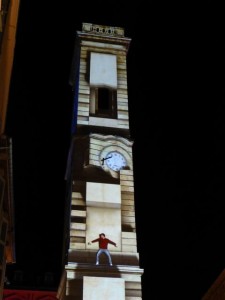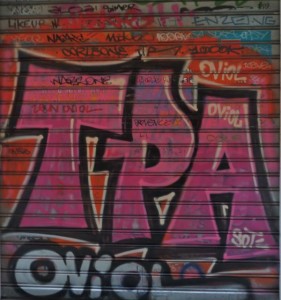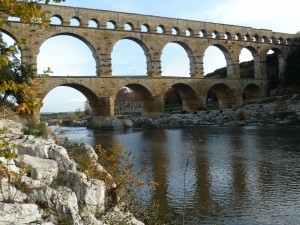-
Archives
- November 2017
- November 2016
- October 2016
- April 2016
- March 2016
- November 2015
- February 2015
- July 2014
- June 2014
- October 2013
- January 2013
- October 2012
- July 2012
- April 2012
- March 2012
- February 2012
- January 2012
- December 2011
- November 2011
- October 2011
- September 2011
- August 2011
- July 2011
- March 2011
- February 2011
- January 2011
- November 2010
- September 2010
- April 2010
- March 2010
- February 2010
- March 2009
- February 2009
- March 2008
- February 2008
- November 2006
- August 2006
- March 2006
- August 2005
- July 2005
-
Meta
Monthly Archives: January 2013
The Calcutta Times-Part 2
The Food Issue…
Snack time:Calcutta has a great subway, complete with air conditioning (sometimes) and a Ladies section in each car (always). During monsoon season, you may be hot and sweaty on the subway, but in the Ladies section you are safe as you swelter. Men don’t ever try to stand there and any who cross do so with rounded shoulders and apologetic eyes.

It’s a ten-minute walk along quiet streets to my metro stop. At one corner is the snack man, who toasts grains and nuts on demand. I’ve sampled a variety of snacks, including his most popular-based on puffed rice–along with my usual: hot, roasted peanuts in a newsprint sack, complete with a little twist of paper holding spiced salt to sprinkle on top. One day I branched out and asked for popcorn. Snack man dumped corn kernels into a small wok filled with what looked like ash. Well, I thought, street cooking is what it is. I didn’t expect him to haul out an Orville Redenbocker popper from under his cart. Still, ashy popcorn wasn’t my dream. How would I eat the stuff?
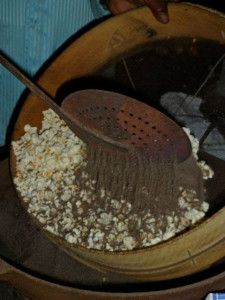
He tossed, stirred and shook, and pretty soon the kernels began popping, so he placed a sieve on top to prevent them spraying into the street. When the ash was studded with ivory popped corn, some still doing startling little jumps, snack man dumped ash, popcorn and all into the sieve, from where the ash drained off, leaving clean popcorn on top. I asked the man next to me why everything was cooked in ash. “Not ash!” he said. “Glash. Glash!” This took me a minute. Glash? Then I remembered that in Bengali, “s” is pronounced “sh.” Glass! He meant cooking sand. Doesn’t stick to food. Conveys heat. Reusable. Of course.
Street food: I’ve had several street meals, a biryani here, a glass of fresh OJ there., always from a stand that’s busy. My favorite is the egg roll. Forget about the tiny, deep-fried roll filled with dreary cabbage that comes with your lunch special at Woo Fong’s. A Calcutta egg roll has nothing to do with that. First, a chapatti is rolled from a fresh mound of dough, then slid down the side of a wok into a puddle of smoking oil. When dough meets oil there’s an explosion of steam and sizzle. Next a handful of thinly slice red onion is flung in, along with a deep-fried carrot patty I’ve selected from the stand’s smeared plastic cabinet. Salt, pepper and fresh cilantro are sprinkled on top. A bottle of thick brick red sauce is offered. I shake my head. A bowl of devilish green chilies is lifted. Another internationally understood No from me. A grimy shaker holding red powder appears. The cook, dressed in a blue sweat suit, eyes his partner who sits on the sidewalk grating vegetables into a soiled pink tub. They both lean back in laughter. I take this as a sign for me to decline once again.
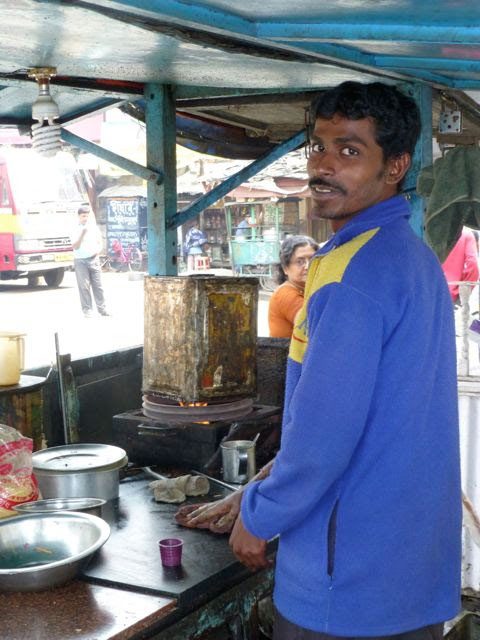
Now for the grand finale: the onions+patty mix is pushed aside. Another large spoonful of oil is dolloped into the wok, and an egg cracked in which splutters and spits as it hits the oil. The chapatti is placed on top just long enough for the two to bind. Then it’s flipped, the veg mix is spooned onto the now-fried egg and the whole savory slab is lifted onto a board where it’s rolled like a jelly roll, wrapped in paper and handed to me. By the second bite I’m into creamy egg yolk, crunchy fried vegetables, steaming onions all savory with herbs and spices in a soft wrapping studded with toasty bits from the frying. It is so delicious I’m able to ignore that the wrapping paper is immediately soaked with surplus oil, which soon also coats my fingers.
Cooking school on the Bengali dining terrace. Protima, Sibhani, Payel and Puja joined me on the Soma Home roof for a cooking lesson. We made ratatouille. Puja (stirring, below) sniiffed the Herbes de Provence I’d bought at a fancy supermarket and declared, “It smells just like Pizza Masala!”
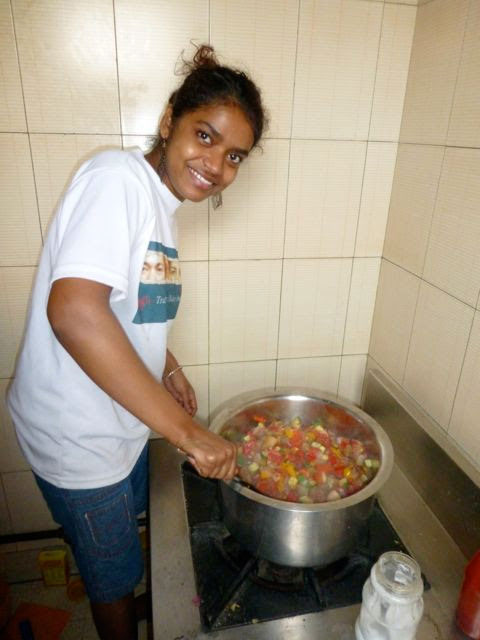
My use of four tablespoons oil for a large pot of vegetables caused Sibhani, who’s 12, much concern. She tapped my arm politely. “Dina-aunty,” she said, her eyebrows knitted in dismay. “More oil, I think.” She didn’t want me to be exposed as a cooking fraud.
“Well, let’s wait and see,” I told her, though I was unsure myself whether, given the strength of the industrial burner we were using, she might not be right.
“More now, I think,” she said after another minute, staying polite to her elder while hoping to convey the vegetables were about to singe into charred gunge.
“Let’s give it a little time, to see what it does,” I bargained.
Another few minutes and SIbhani was beside herself with anxiety “Aunty,” she jiggled my arm. “More oil NOW.”
To distract her, I handed her the large spoon to stir up the vegetables. Relief turned to amazement when she discovered enough liquid below to prevent the ratatouille from burning. Dina-aunty’s stature remained intact.
When I returned later that evening, everyone had sampled the French food. Most of it was still in the pot. “Very good!” declared Smrithi (below left). “Dina-aunty, so tasty,” said Rani. Protima, who is an orphan, just hugged me and smiled. Mere politeness, as I soon learned: “But not spicy!” they all shouted together and ran down the stairs laughing.

This cooking experiment was an exchange, actually. In return, I helped make chicken curry masala, the curry referring to the fact that there’s gravy, and masala meaning spices.
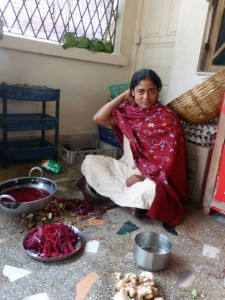
Here’s a great tip: To make the curry gravy, heat your oil and then add sugar–big crystals, not fine. As it caramelizes in the oil, add whatever onion and spices you’ll be using, along with loads of pureed garlic and ginger. The whole thing blends into a thick, fragrant yellow sauce, redolent of turmeric, cumin and caramel, ideal for coating and simmering your chunks of meat. With relief the girls used a good couple of cups of oil for their chicken dish. I’m sure you could get away with just four tablespoons!
Life in Calcutta hasn’t been only about food. We had a day at Maidan park where 11 young girls were introduced to horses and had their first horseback ride! You can imagine how that touched my heart, even though the horses were the size of burros.
We’ve had photo sessions in my room and in the Soma Home yard. Neha (below) is seven. She was taken into Soma Hpme to get her away from her mother, who beat her continually. One afternoon even the cleaning masi (assistant), whom we call Baby-masi because of her size, got into the spirit, pulling off my RayBans and turning herself into quite the Bollywood siren!
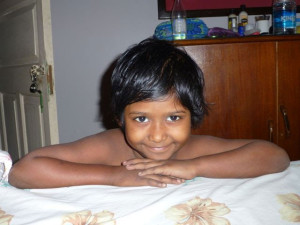
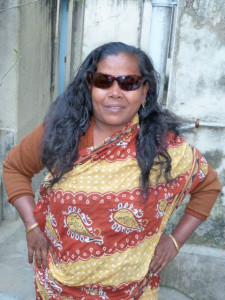
Last note: A few days ago I interviewed Guria. She’s a sex worker whose tall, beautiful daughter lives at Soma Home. Guria lives in a courtyard behind New Light, shared with her in-laws, who were playing cards outside when I walked by.

To talk comfortably we sat cross-legged on her bed, while her TV blared a Bollywood tragedy, punctuating our conversation with the heroine’s frequent sobs. The short bed took up half the space, which was perhaps 8×10. Decorating the walls were posters of movie stars beside favored gods with faded marigold garlands draped over them.
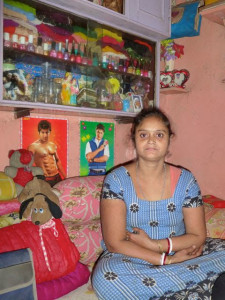
Her daughter’s academic trophies studded the small glass wall cabinets. Looking at these last, I noticed an astonishing array of nail polish bottles. I pointed to them and we laughed hard as I began to count. Forty-two in all! “I have a client who owns a salon,” she confided. “Sometimes he brings me nail polish!”
When our interview was done, I couldn’t help myself. “Let’s put some on!” We perused the gay offerings, everything from pale iridescent green, to purple, metallic grey and all shades of purple and red. Guria chose the color. Here’s the result!

Posted in Dispatches, Nimes, France / Calcutta
Leave a comment
The Calcutta Times-Part 1
Come along with me…..
Sangita Dey was driven from her village home by profound poverty. Actually, that’s not strictly accurate. Profound poverty didn’t drive her from her home. It drove her to believe a man who came to her village, promising he would take care of her and her children if she followed him to Calcutta. Being beaten and sexually molested by your husband’s family will leave you vulnerable to such talk. With her two baby daughters, Sangita followed him. And indeed he took them to Calcutta. To a red light district.
Why not flee to her own family? Because her mother, a sex worker, had already died of AIDS. She never knew her father, only his name.
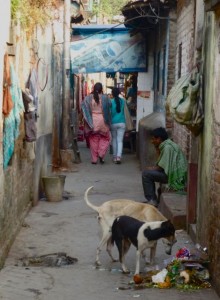
Sangita went into a line of women working the street. She made nearly $6 that first night, more than she’d ever had in her life. Nearby she rented a room, where she lived with her two little girls. Every evening when she brought clients there she would put the two girls outside and tell the older one “Hold on to your sister and don’t let anyone take her.” Each time she emerged from her room she would find Juma crouched nearby, her arms wrapped tightly around the baby, hugging her to her chest.
Turning three to four tricks per night at three dollars each, and paying only a few cents for rent, Sangita and her girls were no longer hungry. They went along like this for several years. But Juma was growing up wild. By age five she was unmanageable, and her sister Jasmin was following her lead. Sangita feared for them. And also, perhaps, felt burdened by them. When a friend introduced her to the founder of New Light, an NGO pursuing gender equality in India and providing full shelter for sex workers’ children, Sangita asked them to take her two girls.
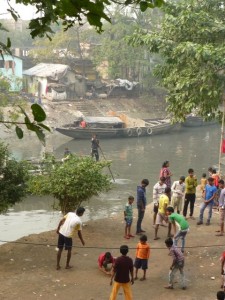
That was nearly seven years ago. Things have turned out well for Sangita, who sat with me for an hour sharing her story. And of course I know her girls. I live in the same house as Juma, who’s now a bright, but naughty 11 year-old, going to school and staging dance competitions with her friends at Soma Home, the group home run by New Light. And Jasmine likes to play Angry Birds on my iPad, when I’m at the New Light crèche and shelter where she lives full time, in a different neighborhood from her sister. As for Sangita, she’s married and working as an office lackey. She visits her daughters often. But she has not taken them home.
For these few weeks that I’m in Calcutta, I’m in the midst of such stories. I’m living with the 33 girls who are sheltered and supported at Soma Home, New Light’s house for girls ranging from 9-18. Nearly all are daughters of sex workers; some have mothers who have already died, perhaps from AIDS, perhaps alcohol. Some have mothers who saw men eying their daughter when she was only 7 and feared for her safety. Some are daughters of women who have left the sex trade, thanks to micro-credit from New Light, and the desire not to shame a daughter who was now so well educated. Some have mothers who do not want to care for daughters, but who dote on the sons they keep at home.

We eat together, make up word games with Bananagrams, share stories. Sometimes I help with lessons. On weekends, I’m allowed to take the young girls to a park to play. With the older girls I go to a Bollywood movie, for an evening of quite wild entertainment fortified by chips and Pepsi. Tomorrow some girls will teach me to cook a favored Bengali chicken recipe, and I will teach them how to make ratatouille. Eggplant, zucchini, tomatoes and onions are plentiful right now. As one of them said when she asked me the name of the dish we would cook: “Oh, if I tried to say that my teeth would fall out!” Surrounded by exceptional grace, I feel too clumsy to broach the idea of learning a Kathak dance. Then again, I do have good teachers sleeping right above me, so perhaps osmosis will work.
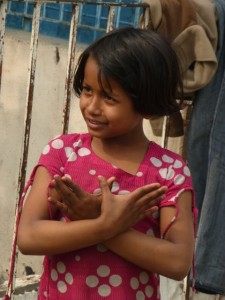
During the day I also go to the New Light crèche, which shelters the younger children of sex workers, 35 or so who live there permanently and another 100 who come for a snack, a rest, and a clean, quiet place to play with friends or get help with their studies. It’s there that I interview the Moms, though I also go to their homes if they live nearby.
The children’s shelter is in Kalighat, which is an old neighborhood, full of narrow lanes and crumbling buildings, loud with hawkers, blaring music and honking horns. To have credibility with the women it seeks to serve, the shelter is right in the midst of the red light area.
Several sex workers at a time stand or squat at the entrance to the narrow, fetid alleyway where the shelter is housed in the ruins of an abandoned temple. To get there, I walk down the damp pavement, by women sitting on curbstones, past windowless rooms the width of one narrow bed, around mangy dogs nosing garbage, side stepping a man bucket-bathing against the wall. A fat woman pushes one enormous breast back under her sari. A few people cluster together, talking loudly. I hurry my step, not sure if this is standard Bengali talk or a prelude to a fight.
As I walk I try not to breathe the cool reek that wafts from a dark courtyard, as it clashes with the warm stench flowing off the canal at the alley’s far end. Through a communal 8×8 courtyard, up a narrow, tiled stairway and I’m on the roof terrace which houses the New Light crèche and offices.
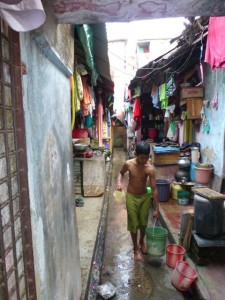
For the children of Kalighat, it’s a haven of laughter and lessons, of regular meals, naptimes, friendship and hugs. Without fail I am greeted by one child or another who either races to me and hugs my waist hard, or clambers into my lap begging for another chance to type on my iPad keyboard.
But before that, I always stop at the top of the stairs to greet a wizened, slip of a woman with a deformed hand. She lives in the 6×8 room at the top of the stairs, with her ancient mother and her alcoholic husband.
Yesterday I saw her right eye was bloodied red. When I arrive she wraps her arms around her mother and points her chin in disgust at her husband. He’s asleep crossed-legged, leaning against the wall, one arm flung out toward a filthy plastic water bottle filled with an amber liquid. We squat together for a few minutes and she stares deep into my eyes, her toothless mouth working in outrage and pain. She brings her twisted hand to her cheek and winces.
By contrast, Soma Home is in a nice, lower middle class neighborhood. It’s quiet here, residential. There are towering mangos, palms, shrubs. The streets are wide and deserted. It’s hushed enough in the early morning that I can here pigeons cooing. A heavy padlock secures Soma’s entrance gate, mainly to keep unwanted visitors out, though also to ensure the girls stay in.
If you knew nothing about the girls’ history, their intelligence, exuberance and talent would persuade you you’d stepped into a girl’s camp. A somewhat crowded, noisy camp, with thread-bare sheets on the bed, girls sharing clothes and shoes, not having any personal belongings to speak of, and never receiving letters from family, but otherwise just the same.

There’s the teenage group that trains in boxing 3x/wk with Razia, national women’s coach, judge and boxing referee. There are the middle girls, into crafts and making cards and bracelets for each other. There are the younger girls, who stage their own version of Dancing with the Stars.
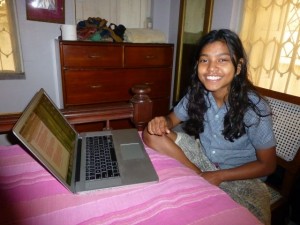
School is de rigueur, meals are nutritious, discipline is clear. Everyone takes a turn helping the cook prepare. TV is allowed only on weekend evenings.
The girls at Soma Home are a joy to be with. The pure happiness in their eyes when a mother comes to visit (each Mom is allowed to come once a month) is a sight to behold. The mothers are so proud of their daughters. And the daughters clearly are devoted to their Moms.
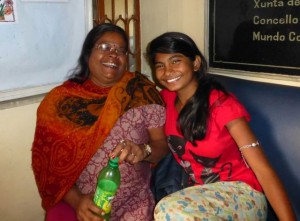
Every one has a story that would break your heart, and by rights should have broken theirs. But they’re strong! They’re optimistic!
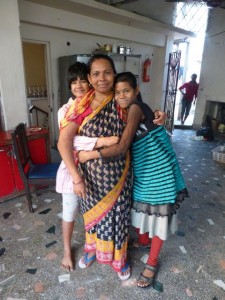
They have dreams! They love movie stars!! And nail polish!! Today we went to a great shopping mall, to buy the ingredients for that ratatouille. In the food court I spied a Subway serving chicken tikka and chicken achari subs, 6” and 12” versions, of course. And KFC offered a bucket of chicken curry drumsticks that I bet would be an instant hit in the U.S. Have I conveyed at all that this is a special place?
Note: The story of Sangita is a composite. Though I made up a name for her, the story itself is neither better nor worse than any history I’ve been told.
Posted in Dispatches, Nimes, France / Calcutta
Leave a comment
The Nimes Report- Part 4: Christmas finery
The city of Nimes puts on a light show at its main monuments that is a stunning display of video artistry. For a full week spanning Christmas, the light shows run continuously for three hours, starting right after dusk. The one on the clock tower was around the corner from our apartment. Every night the crowds got larger, as people stood, jaws dropped open, as it appear a young man in jeans and a red sweater was sauntering around the tower’s edge, 60 feet above the ground.
Because the images were full of movement, I had a hard time catching them, but did manage to get enough good ones to give you an idea of what Nimes put together. Considering that Nimes is just a small town, we were impressed to the tips of our cold noses that they invested (or squandered?) so much public money on these projects. We made sure to enjoy every bit of them.
First, here’s the clock tower as it looks when unadorned:
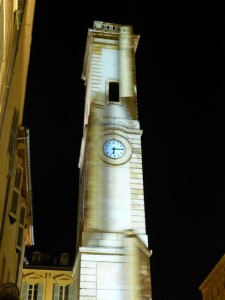
Now here’s the clock tower under the influence of the multi-camera moving video:
After watching the clock tower display families wandered the five minute walk to the arena, where they saw a continually moving, shifting version of the stills below. if you think about how irregular and crumbly a 2,000 year old arena is, it’ll give you an idea of what a feat of creation this video is, where every colorful projection matches the arches, stones and columns of the arena perfectly.
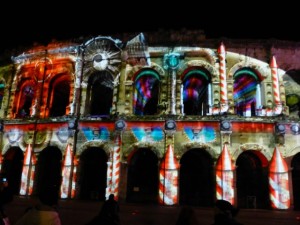
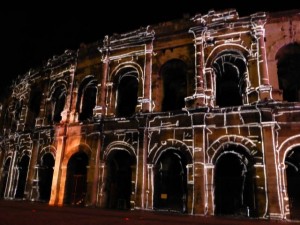



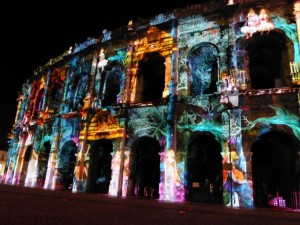
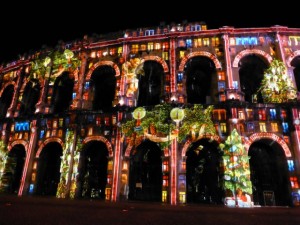

Posted in Dispatches, Nimes, France / Calcutta
Leave a comment
The Nimes Report-Part 3
In which we say Hola to Spain…..
Nimes is barely an hour and a half from the Spanish border, so we decided to head to Spain for a short week. First we drove along the Costa Brava, with its arid mid-section leading down through granite cliffs to little coves lapped by gentle waves from a cerulean sea. We lunched on tapas in the white-washed fishing village of Cadaques and slept next to the El Far lighthouse in the white-washed fishing village of Llafranc.

It looks pretty idyllic, but looks, as we all know, can be deceiving. We get fresher fish at Les Halles in Nimes. You may find it surprising to learn that intrepid Brunhilde did not make the trip with us. Instead we drove an Avis car. It turns out that European parking garages are for tiny (read “fuel efficient”) cars only. Brunhilde’s stature simply doesn’t suit, as attested by the dent in her roof as Bernard was backing her up in a particularly tight spot in one garage. Did I just say that Bernard dented the car? Yes, I did!! Of course, Bernard didn’t make the dent; the section of concrete bulging from that garage’s absurdly low ceiling did. Still, the number of bonus points ka-chinging into my “Mistakes” account is hard to believe!!
It took me all of half a day to fall in love with Barcelona. And half of that was spent with my jaw open, in and around Gaudi’s Sagrada Familia cathedral. You’ve probably seen images of this unfinished masterpiece. So have I.
Those photos don’t convey in the slightest what it feels like to be inside the building. I was spellbound by how Gaudi was able to take the basics of gothic architecture and create a space of such tremendous warmth and light. The man was a genius and we spent our several days in Barcelona enthusing about the houses, buildings and parks that were designed by him.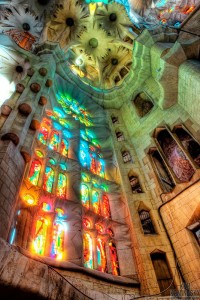
Barcelona also is famed for its version of Les Halles, called Boqueria. I don’t know what it is about markets, but I never tire of wandering around them. And if fruits are just too healthy for you, stick your hand in some of the candy bins which do a good job of mimicking the bright colors of real life.

!!!!SPOILER ALERT!!!! DEAD ANIMAL PARTS ABOUT TO BE DISPLAYED…..
Boqueria is the place to go if you want truly young animal parts for your meal: suckling pigs that were barely a foot and a half long, infant lambs. And there was the usual complement of body parts that aren’t usually mentioned in polite U.S. society, but that are the grist of many a succulent meal in Europe.
Even though it was only ten in the morning, we had to stop at one of the lunch counters and eat immediately, garlic be damned. Miniscule squids for Bernard, mammoth prawns for me. We’ve done this a couple of times in Nimes as well, where I get to indulge in rabbit hearts and duck giblets, while Bernard eats a more traditional white sausage with some excellent potatoes.

I have been out and about with my camera, collecting the images you would expect when living in an old French town: church steeples, cobbled lanes, quaint balconies, Christmas decorations.
Still, when one walks narrow stone-paved streets every day it all starts to seem so, well, ordinary. Instead of more cobblestones, Roman arches and stately trees with leaves in the middle of winter, I thought you’d like to see something the French do really well: cute dogs. My subjects were beside themselves with delight to be in such demand. The young ones couldn’t hold still, the old ones just wanted to get back to bed, while their owners cordially regaled me with the particulars about their pet. In order of appearance, I give you: Hungry 6 mos: crepe stand dog; Viva 8 yrs; Pelouche, 2 yrs; Baccio 3 yrs: tea room dog; Canelle 13 yrs; Monsieur Fenetre: doing his job.


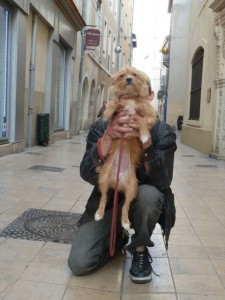



Every evening the shops in the pedestrian old town of Nimes and Barcelona pull grills and metal shades over their front windows for the night, irresistible canvases for street art. Seeing them throughout the town, one after another, I was struck by how much brashness and color they added to the cold beige stones of buildings and alleys. I think when you see them all together, you’ll get some of the same impression I did.
Here’s the next amazing fact about Nimes which I promised you. In 1530, a certain Jean Nicot was born in Nimes. As ambassador to Portugal he spent two years there organizing the marriage of a French toddler to the 5-year-old King of Portugal. The little princess refused to stop growing long enough to fit in her wedding dress. The king was more interested in his toy carriages. On his return to France he brought with him certain plants that enabled him to introduce snuff to the French court, quickly hooking Catherine de Medici. In thanks for his assistance, the plant was named after him and we remember him to this day with the word for that perniciously addictive chemical in cigarettes: nicotine!!! Which is why I find it so amusing that there’s this shop in the center of town:
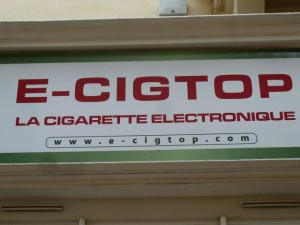
The Nimes Report-Part 2
Here’s me at the end of our flight from Denver to London in mid-November. Honestly, I felt more cheery than I looked. After all, I was arriving in the EU, of which I am now a member.

Brunhilde fairly leapt for joy when we drove out of the LandRover-crammed storage lot where she’d been cooling her wheels for the past year. Ahh, the delight of being back on the road again, finger on the map, uhh, I mean ear cocked to the British voice on our new Tomtom GPS who (which?) politely but firmly told us every move to make and then repeated it three times. I am trying to take heart and learn from her example, but it’s discouraging. My British accent just doesn’t cut it. And then there was the thrill of crossing the English Channel (why does no one call it the French Chanel?) in only half an hour, on a dry (that IS the point) and efficient car-train.
That was followed by the damn nuisance of the French toll roads whose pay machines could not understand our American credit cards, continually rejecting them in favor of cold, hard curos. Not to mention the utter unfairness of the dense fog that obscured the undoubtedly lovely countryside we drove through for two and half days. The new GPS proved her worth by guiding us to a garage when Bernard mistakenly filled Brunhilde’s empty tank with high octane gas instead of diesel. Wait! Did I just say that? Yes, I did. I have so many bonus points in my “Someone else made a mistake,” account that I don’t know what to do with them!!!
We did stop for certain marvels, like the steel Pont Canal which spans the Loire in Breare; a certain Mr. Eiffel of Tower fame was part of the design team. This aqueduct carries a side canal OVER the Loire and is entirely navigable even though it goes above the river. We saw a good several feet of it……
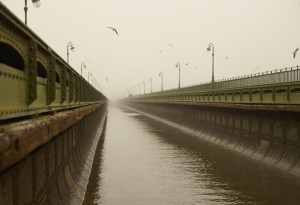
In what has turned into quite an aquaduct-related trip, we also saw, and drove over, this marvel, which spans the river Tarn near Millau:
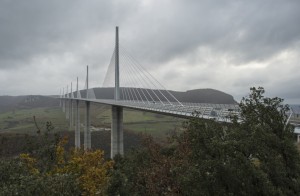
But all that is a tale from far-away times, as since then we have been enjoying a peaceful existence a mere stone’s throw away from southwestern France’s best bakery as well as a most lavish indoor market.
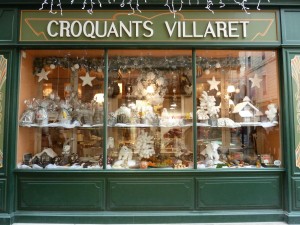
Our routine is firmly established. Early morning one of us walks the 100 yards for a fresh baguette for breakfast. Some time later, I take two satchels and head to the market for fresh fruit, salad, radishes, olives and whatever else strikes my fancy. We eat all day long….and I don’t have to prepare any of it! Thank goodness for the three flights of stairs to our garret apartment; I call it my free, personal Stairmaster as well as proof that, despite my French passport I remain sadly calorie-conscious.
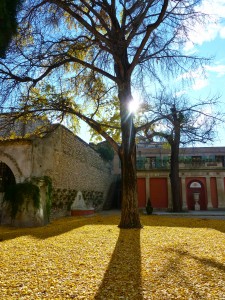
We’ve had visitors, too, with whom to share our local pleasures. Bernard’s sisters Odile and Laurence have both spent some days here. We’re eternally grateful that both of them brought sunny and warm weather with them, so we could eat lunches outside on our rooftop terrace.
To be honest, believing in a snowy winter here is kind of a stretch. Even the stringing of sparkly lights cannot disguise that palm trees in the small squares of old town, where we live, have fronds, not needles.

The evergreens that the city has splurged on to winterize each plaza have been sprayed with a white gunk more reminiscent of melted marshmallow than snow. Despite the dearth of snow, it’s definitely been chilly enough on many days for me to happily patronize the street stand where a large paper cone of roasted chestnuts warms my fingers before becoming a satisfying afternoon snack. And there’s a kiosk serving hot mulled wine in the plaza below, which I have my eye on. The rivers of lights overhead on the pedestrian streets are a dreamy vision on a warm evening when Bernard and I go out for an aperitif at a nearby bar (yes, I realize everything is nearby here), or in search of a new restaurant to try for dinner. We saw them being put up, which is kind of like seeing your Dad put on a Santa beard the night before Christmas.
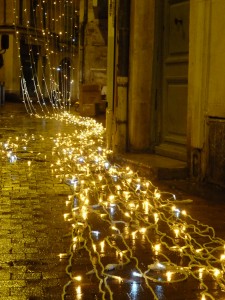
We’ve accomplished a lot of regional inspecting, visiting quaint cobble-stoned villages like Uzes, the bustling university city of Montpellier, along with the well-known towns of Arles and Avignon. In Arles we caught the acrobat act of a small traveling circus; human and goat alike performed daring feats of balance before our very eyes!!
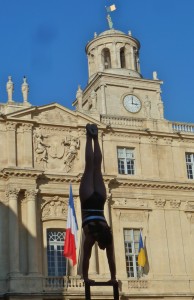

We’ve perused the countryside in between, where treasures such as the Pont du Gard still capture the imagination.Part of a 50 km aqueduct built in the first century AD, the bridge stands 160 feet high and carried 44,000,000 (not a typo!) imperial gallons of water to Nimes every day, which back then was one of the Roman Empire’s great outposts. We feel especially fortunate to be here in the winter, when the lovely old buildings and squares are quiet and empty, rather than the summer when even seeing the cobblestones underfoot would be an accomplishment, so crowded is the region at that time. Even our few days in Paris, accessed by superfast train in 3 hours (!!!), were a pleasure of normalcy.
As Christmas approaches, Nimes is lighting up all its monuments, including not only the arena…
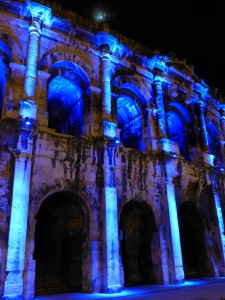
…but also a ferris wheel which is the crowning feature of a children’s amusement area just outside old town.

I have been indulging in two photographic studies, which I will share with you in Part 3 of this newsletter, along with some amazing bits of information which I am certain will impress you as they did me.










